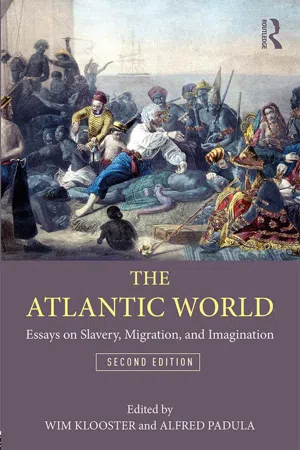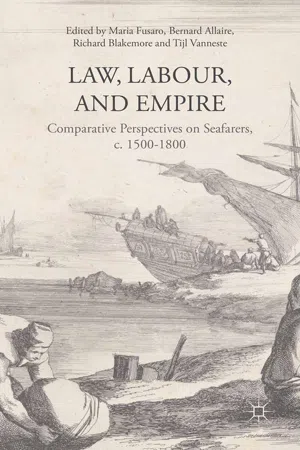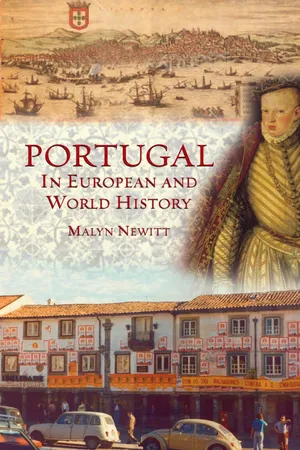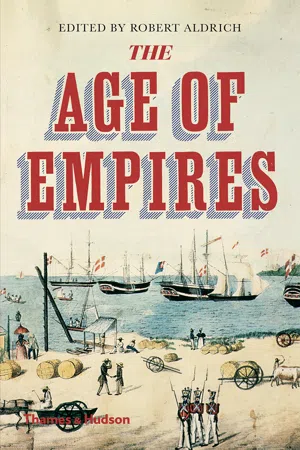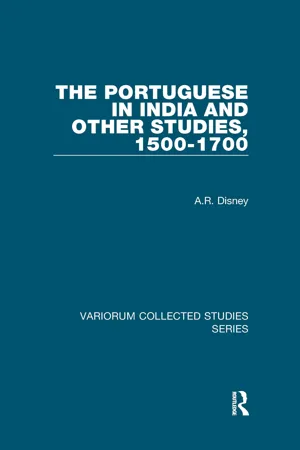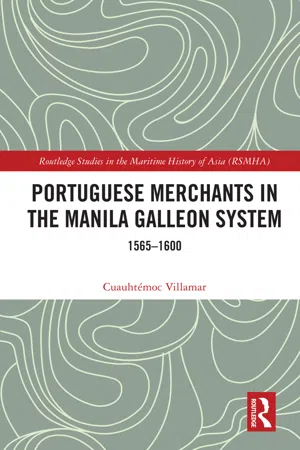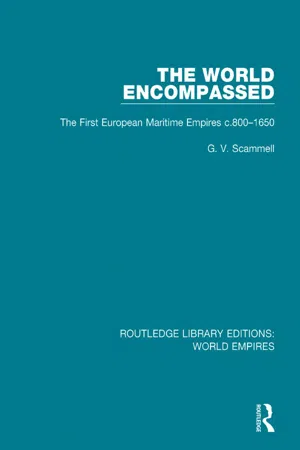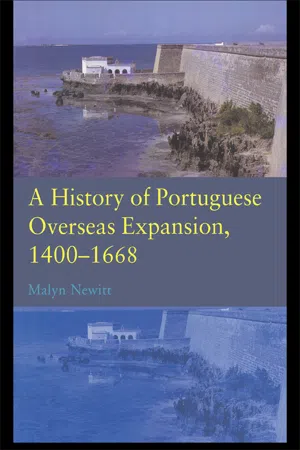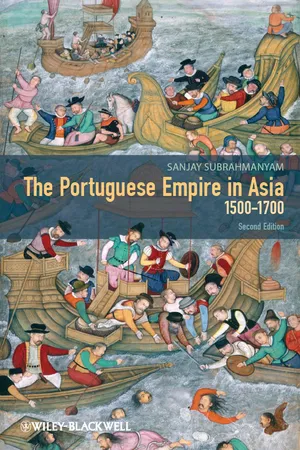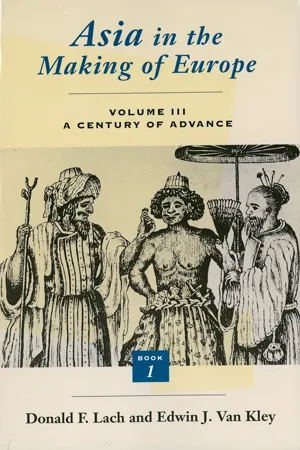History
Portuguese Maritime Empire
The Portuguese Maritime Empire refers to the vast overseas territories and trading posts established by Portugal during the Age of Discovery, particularly in the 15th and 16th centuries. This empire was built through maritime exploration and conquest, and it included territories in Africa, Asia, and the Americas. The Portuguese Maritime Empire played a significant role in shaping global trade and exploration during this period.
Written by Perlego with AI-assistance
Related key terms
12 Key excerpts on "Portuguese Maritime Empire"
- eBook - ePub
The Atlantic World
Essays on Slavery, Migration, and Imagination
- Willem Klooster, Alfred Padula, Willem Klooster, Alfred Padula(Authors)
- 2018(Publication Date)
- Routledge(Publisher)
Portugal became the first modern European nation-state to establish maritime colonies outside of Europe, thanks to the ruthless application of superior seaborne technology—artillery mounted aboard strongly built ships. Portugal developed a complex network of rich maritime enclaves on three continents beyond Europe. By the first quarter of the sixteenth century, far-flung Portuguese holdings in all the world’s oceans possessed colonial administrations—some entrenched and some precarious—that looked to Lisbon for law, protection, and a cultural standard set in the Iberian metropole. The Portuguese established imperial bases in Morocco, Madeira, the Azores, Guinea, São Tomé, Princípe, Cape Verde, Brazil, Angola, Mozambique, Zanzibar, Mombasa, Hormuz, Diu, Damão, Bassein, Goa, Cochin, Ceylon, Malacca, Timor, Tidore, Ternate, the Banda Islands, Macau, and Nagasaki. Taken together, these territories represent such an enormous geographical area that holding them together as a coherent, viable overseas empire required a mastery of navigation and logistical strategy.Portugal’s ascendancy in the sixteenth century relied on its web of sea links. Garrisons on land were often small and constantly in danger of loss due to disease or local unrest. Authorities in Lisbon administered and defended this network despite enormous logistical impediments and lack of manpower. This shortage of personnel and material and financial resources meant that the full commercial potential of the Portuguese network was never fully realized. The lack of resources—what the Portuguese called falta de condicões —was chronic both at home and throughout the empire; dearth is a constant theme and factor in Portuguese history.An Atlantic Nation With a Focus on the East
Another aspect of the Portuguese paradox is that its imperial aspirations focused on the eastern hemisphere and particularly on India and China for their spices, drugs, textiles, and luxury goods. Asia and the Estado da Índia remained the primary focus of Portuguese imperial energy for nearly two centuries, until the 1680s. The cumulative weight of resources invested in the fifteenth-century explorations, the tremendous effort and amount of treasure expended to establish bases in Asia, and the heavy emphasis placed on the Treaty of Tordesillas (1494), which gave a papal sanction and political legitimacy to Portuguese territorial claims in the eastern hemisphere, dictated that this be so. Despite serious setbacks in the seventeenth century, when many feitorías - eBook - ePub
Law, Labour, and Empire
Comparative Perspectives on Seafarers, c. 1500-1800
- Maria Fusaro, B. Allaire, R. Blakemore, T. Vanneste, Kenneth A. Loparo(Authors)
- 2015(Publication Date)
- Palgrave Macmillan(Publisher)
12
Portuguese Seafarers: Informal Agents of Empire-Building
Amélia Polónia
During the sixteenth century, Portugal – a small kingdom with a relatively small population and few urban centres apart from Lisbon1 – was the first European power to promote regular maritime routes which allowed global exchanges. The idea that this was a process driven by the state is still commonplace, yet the Portuguese crown lacked the financial sustainability and the institutional, bureaucratic and administrative apparatus to effectively control this process and to provide the logistics required by such an enterprise.Consequently, as scholars have shown, the crown depended on the cooperation of individuals, both Portuguese and other Europeans, as well as Asian, African and Amerindian indigenous agents. Voluntarily or under coercion, they supported a process of empire-building which frequently escaped the control of the Portuguese crown.2 Recent studies have shown that these dynamics can be better understood from an historical point of view if one uses the conceptual and theoretical principles of cooperation and self-organisation as well as an agent-based approach.3This paper will develop this perspective further by considering maritime logistics. Portuguese dominion of the seas relied upon informal networks of maritime agents (pilots, shipmasters, sailors) who not only provided the human and technical resources for inter-oceanic navigation but also contributed to vigorous networks of trade and, ultimately, to the establishment of global connections and the dynamics of Portuguese dominion. They were, not always intentionally, agents of empire-building in the Atlantic and Indian Ocean worlds. - eBook - ePub
- Malyn Newitt(Author)
- 2009(Publication Date)
- Reaktion Books(Publisher)
4 The First European Maritime Empire The Estado da Índia During the sixteenth century the Portuguese created a worldwide commercial empire stretching from the China Sea and the Indian Ocean to Brazil and Angola in the South Atlantic. This empire, which was not challenged by any other European state for a hundred years, made a profound long-term impact on the economy and culture of Europe and initiated changes in the relations of Europe with the rest of the world, which can today be recognized as the beginnings of globalization. 1 After Vasco da Gama returned to Lisbon in 1499 from his successful first voyage to India, the king, Dom Manuel I, realized that great profits could be earned from direct voyages to India. War between Venice and the Turks had put a premium on the value of spices imported into Europe and the sea route round the Cape was not only far beyond the reach of Turkish power but enabled greatly increased quantities of spices to be imported. A second fleet was quickly organized, this time consisting of fourteen ships. To equip such a fleet was beyond the resources of the Crown, so Italian and German banks were allowed to invest in the voyage. Its commander, Pedro Álvares Cabral, lost four of his ships in storms (including one captained by Bartolomeu Dias), and engaged in open warfare with the ruler of Calicut (now Kozhikode), the principal pepper trading port of the Malabar coast. Although the voyage produced spectacular profits it showed something of the problems that would be faced by fleets sent annually from Portugal. The ships had no secure base in which to re-equip and carry out repairs and, because of the violence employed by the Portuguese on their early voyages, they now had to contend with a hostile reception in many of the trading ports in the Indian Ocean. Having to fight wars in the East had not been foreseen and raised major issues of supply and manpower - eBook - ePub
- Robert Aldrich(Author)
- 2020(Publication Date)
- Thames and Hudson Ltd(Publisher)
PORTUGALEmpire-building in the Old World and the New
JILL DIASPortugal was the first European country to acquire an overseas empire, and the last to renounce it. By the 1540s, one of the smallest, most remote and poorest nations of Europe had created a merchant empire more than five times her size, stretching around the globe. The imperial centre of gravity shifted from Africa and Asia, to South America before 1600, and back again to Africa in the 1820s. While the orientation of Portuguese involvement overseas changed profoundly, the Portuguese remained omnipresent. Over five centuries, several million people embarked for Asia, Brazil and Africa. Webs of kinship maintained historical connections between different geographical regions, while the ‘imagined community’ of the empire was reinforced by chroniclers and poets, who elaborated a national ideology and mythology of Portuguese expansion. Like all empires, that of Portugal was marked by moments of extreme violence. It played a central role in the overseas slave trade that displaced between 10 and 20 million Africans, producing dynamic new cultural and social syntheses in America. The cultural legacy of Portuguese contacts also endures in identity, language and religion within post-colonial societies, from Japan, Macao, Indonesia, Malaysia and Timor, to Brazil, Angola, Mozambique, Guiné-Bissau, and the archipelagos of São Tomé and Cape Verde. Portugal herself was rarely the main economic beneficiary of the empire, remaining first and foremost a broker. National regeneration through empire was a persistent mirage, and Portugal remained as poor and backward at the end of empire as at its beginning.African beginnings: from Ceuta to the Gulf of Guinea1
Portuguese expansion began with the invasion of North Africa and conquest of Ceuta by a crusading army in 1415. The campaign pleased the papacy, eager to recover Christian lands separated from the Church centuries earlier by Muslim political supremacy in the Mediterranean, and it put Portugal on the map internationally. The expedition’s planner, the Infante Henrique, Prince Henry ‘the Navigator’,2 - A.R. Disney(Author)
- 2023(Publication Date)
- Routledge(Publisher)
II The Portuguese Empire in India c. 1550–1650 Some Suggestions for a Less Seaborne, More Landbound Approach to its Socio-Economic History Some forty-five years ago J. C. Van Leur commented to the effect that historians seemed too often to be viewing Asian history from the very limited perspective of an East Indiaman’s deck. 1 Insofar as this criticism referred to explicit assumptions of European superiority it is probably for the most part no longer applicable; but in respect of Eurocentric preoccupations it remains, at least in certain areas, substantially valid. This is demonstrably so with many studies in the economic history of the Portuguese empire in Asia which, while they have in some cases achieved great advances in our knowledge and understanding since Van Leur, have nevertheless been largely confined to the essentially European-orientated themes of maritime trade and communications. 2 The reasons for this concentration are fairly clear. It has long been a practically unquestioned historiographical assumption that the Estado da India was, in its economic aspect, almost exclusively a maritime trading empire, and had very little territorial importance or interest. The notable Indian historian K. M. Panikkar, while he cogently exposed some of the European prejudices that had characterized earlier writing on Europe in Asia, appears to have been particularly anxious to stress the Portuguese empire’s alleged territorial insignificance — thereby indirectly reinforcing the traditional emphasis on its trade and shipping. 3 Western economic historians in this field have overwhelmingly maintained these preoccupations. This is doubtless partly because the European documentary sources for the history of Portuguese seaborne commerce in Asian waters are comparatively rich, and have offered opportunities for fruitful research- eBook - ePub
- Cuauhtémoc Villamar(Author)
- 2020(Publication Date)
- Routledge(Publisher)
32Looking mainly for spices, the Portuguese could also catch a whiff of the best commercial opportunities despite the dangers of the long-distance trade. Sailing through maritime routes that few other Europeans adventured; crossing borders of empires, climates and cultures, they found chances to multiply their riches. They adapted themselves to the ways of trading in a range of societies, where the magnetism of high-value merchandise was persuasive enough to transmit their requests without interpreters. Their commercial skills allowed them to crowd out competitors, for example, in the sandalwood market from Timor.33 By the second half of the century, the Portuguese merchants had accumulated broad experience in Asia. Their know-how was transmitted across generations and acquired two major characteristics: many merchants had settled down, become localised or Asianised , and felt free from the rule of Estado da Índia . After the second half of the century, the Portuguese behaved in most Southeast Asian ports very much like Asian traders.34There is an additional reason for this type of adaptation of the Portuguese overseas. Since the initial times of the Portuguese administration in Asia, a duality had surfaced in all the decisions of the crown in its extensive between centralisation, known as dirigisme , versus its tendency to allow the private actions of the Portuguese in those territories, dubbed as grande soltura (great freedom). The governor of Estado da Índia , Lopo Soares de Albergaria (1515–1520), was the leader most identified with the concept of free movement. This great freedom prevailed in the region, perhaps as a simple recognition that it was not possible to control the activities of all the Portuguese in Asia.35 - eBook - ePub
The World Encompassed
The First European Maritime Empires c.800-1650
- G. V. Scammell(Author)
- 2018(Publication Date)
- Routledge(Publisher)
These fanciful dreams were not realized, and by the mid-1500s Portugal’s Asian empire had reached its fullest extent. Individuals were indeed to penetrate further still, merchants or seamen to Manila, New Guinea and the Seychelles in the later sixteenth century; missionaries to Vietnam and Tibet in the early 1600s. At the same time local hostility, European competition, and the ever-growing power of Islam brought a search for new bases and new allies. Nevertheless the essential character of the empire remained unchanged. Whatever the grandiose titles concocted at home, or the bellicose language of imperial correspondence, the Portuguese were notoriously not, as were the Spaniards in America, rulers by conquest of subject millions. Their territorial possessions were few; colonization – in face of a hostile climate, organized and populous Asian societies, and their own demographic weakness – was insignificant. Instead, Portugal’s eastern empire was a string of fortresses and factories – the very worst to defend – sustained by, or potentially controlling, maritime trade routes. In this, though the product of a remarkably non-mercantile society, it resembled those of the Hanse and Venice. Similarly, as in their empires, long-distance trades were complemented, and often overshadowed, by local ‘country’ traffics. And, as with Genoa, the fragile authority of the parent community and the limited opportunities it offered, encouraged individuals to trade where the flag of the mother country could never hope to follow, and ensured that Portuguese commerce long survived the demise of Portuguese rule. But Portugal enjoyed nothing of the economic hegemony of the German or Italian cities. Her commercial monopolies were less effective, and her empire – isolated survivals apart-far shorter lived. Simply a seapower of modest strength, she controlled no inland bases, and stimulated no such spate of urban foundations as the more intensively commercial Hanse. And reflecting its peculiarly monarchical and aristocratic origins, Portugal’s empire was largely geared to plunder, and to the conduct of a trade even more exclusively devoted to luxuries than that of Venice (cf. pp. 101ff).At its brief zenith, lasting only until the early 1600s, it comprised a number of distinct but interlocking economies. The remotest centred on Macao, the only Asian city truly created by Portugal. Here, presumably with the connivance of suitably rewarded Chinese officials, and without the knowledge of either the Chinese or Portuguese governments, a settlement grew up. By 1600 it was one of the most important in the east, prosperous, to all intents independent, and enjoying privileges conferred by both China and Portugal. The city housed in style between 400 and 600 married males of Portuguese birth or descent. Together with their children, wives and mistresses – gorgeous Orientals, Africans or Indians, visitors enviously noted – their slaves and retainers, they made up a total multi-racial population of about 20,000. Macao handled a commerce of insignificant volume, but impressive value, its basis the monopoly of trade between China and Japan.9 Chinese gold – abundant but little esteemed in its own land – and silks were exchanged for Japanese silver at a rumoured overall profit of 150 per cent simply on bullion. But dealings quickly grew more complex. To meet Chinese demand silver was brought in from countries as far apart as Persia (through Goa) to South America (via either Europe or Manila in the Spanish Philippines). And besides silver – of which Japan alone provided 26t a year by 1600 – Indian spices and textiles, together with such European novelties as prisms and lenses, were also sent to Canton. Chinese silk, Indian and European goods, were shipped to Manila,10 - Malyn Newitt(Author)
- 2004(Publication Date)
- Routledge(Publisher)
At its height the territorial power of the Estado da India covered tens of thousands of square miles—comparable in extent to the territory held by Portugal in the Atlantic. Moreover there were plans to make further conquests in Sumatra and in China which, for various reasons, never materialised. The Estado da India was as much an empire of settlement as the empire in the Atlantic.The global trading system
During the two and a half centuries covered by this study, the Portuguese established a worldwide trading system. At first their trade outside Europe was narrowly restricted to West Africa, the islands, the Mediterranean and North Africa, and was partly absorbed into the already existing commercial systems of Genoa and Venice. However, following the opening of the sea routes to Brazil and India and the subsequent voyages by Portuguese navigators to the Far East, the Pacific and the Arctic, commercial networks began to be established on a truly global scale. As early as the second decade of the sixteenth century Indian beads and textiles were being traded in Guinea and cowries from the Maldive Islands were entering into circulation as currency in western Africa.19 This, it has been argued, constituted an economic revolution of profound importance. As Meilink-Roelofsz wrote,And Charles Boxer wrote that,the establishment of a political sea power with an economic goal supported by a commercial organisation operating from one central point and from one port of loading which linked both western and eastern Asia and therefore made centralised inter-Asian trade possible, was something quite new in Asia.20the Portuguese dominated (where they did not monopolize) the maritime trade of Asia for the best part of a hundred years…though the pax Lusitanica had its seamy side, it indubitably contributed to the advancement of commercial technique and prosperity in this quarter of the globe.21Not all writers have been so convinced. It is clear, for example, that the volumes of trade handled by the Portuguese were relatively small. Even the trade in spices between Asia and Europe, which was the core of Portuguese maritime commerce, probably did little more than double the volumes previously traded by traditional methods. In Asia Portuguese trade formed only a tiny fraction of the trade carried on by Asian merchants. It has been estimated that, in the seventeenth century, the trade conducted by a single Hindu merchant, Virji Vorah, was larger than that of all the European India companies put together.22 Moreover, in many respects, the commercial activity of the Portuguese fitted into the traditional patterns of eastern commerce—single voyages, carrying the relatively small consignments of individual merchants who were organised into small communities of traders, established in their own quarters in the port-cities of the East and distinguished from their Parsee, Jain, Jewish and Armenian competitors by their distinctive dress, social customs and religion.23 In most of Asia ‘Portuguese played a secondary role to Gujaratis, Chinese, Javanese, and Japanese’.24 It can even be argued that the commercial monopolies and privileges of the fortress captains resembled those of the indigenous sultans, rajas and sheikhs who had ruled the port-cities before the arrival of the Portuguese. In many respects, for example, Portuguese rule in Malacca replicated the previous rule of the sultan.25- Om Prakash, Om Prakash(Authors)
- 2020(Publication Date)
- Routledge(Publisher)
The Portuguese expansion in India, by and large, reproduces the characteristic traits of the exploitation of the African coastline: the same purely mercantile economy; the same preference for luxury articles or, at least for those that are rare; the same presence exclusively on the coast; the same mobility of people; the same centralised administrative system served by officials to the Throne nominated every three years. But beyond Ceylon – that is, around the Bay of Bengal, in the seas of the Archipelago and in the Far-East – the Portuguese hold is much closer to the Guinean model: the fortresses are far in between and so are the factories; trade is more of an intermittent kind, seasonal and along the coastline, similar to that of the preceding century in the bays, rivers and lagunae of the Western coast of Africa.Not recognizing the importance of this trade, Portuguese historians, Influenced by the chroniclers who attach too exclusive an importance to military aspects, have often misunderstood the history of the presence of their compatriots in Southeast Asia. If mercantile expansion is mistaken for a conquest, by paying attention only to the warehouse “officially” belonging to the crown, one fails to understand the importance of the region in the economy of the Portuguese empire and of the extent of Portuguese influence on the local populations(1) .Besides, what was called the state of Eastern India (and later the Portuguese State of India) was a thalassocracy rather than a clearly defined territory. Quite paradoxically, the Portuguese Throne appropriated less sovereign rights over the land than it did over the seas and only those holding a cartaz – laissez-passer from the Portuguese authorities – were authorized to travel the seas. Agreeing with the concept, D. Manuel never took the title of king or lord of India, but only of “master of the conquest, navigation and trade of Ethiopia, Arabia, Persia and India” – where territorial domination only appeared potentially as a right to conquer.Particularly in the earlier moments, in fact, the Portuguese had very little concern for the status of their agencies – as long as they had commercial facilities. Albuquerque, therefore, knowing that Malacca had depended on the Kingdom of Siam much earlier, suggested to the Ayuthia court to return its city in exchange for military assistance for waging a battle against the Sultan and for the Portuguese to extablish their naval and commercial base there(2)- eBook - ePub
The Portuguese Empire in Asia, 1500-1700
A Political and Economic History
- Sanjay Subrahmanyam(Author)
- 2012(Publication Date)
- Wiley-Blackwell(Publisher)
jihad between Muslims and infidel Portuguese remained more an ideal than a reality.Concessions and Captains-MajorIf the four decades after 1570 are characterized on the one hand by a growing interest in the land and territorial adventurism, and on the other by the rise of a set of maritime networks to rival those of the Portuguese Estado , one must not neglect the changes that took place in official Portuguese intra-Asian maritime trade either. When Philip II of Spain became ruler of Portugal, these changes were already under way, and they accelerated further in the next three decades.Being a pragmatic ruler – as well something of a workaholic with a mania for paperwork – Philip appears to have commissioned, in the very first year of his reign over the Portuguese empire, a compendium on the extent and nature of his Asian possessions. This text, the Livro das Cidades e Fortalezas (“Book of Cities and Fortresses”) is somewhat misnamed, for at least a quarter of it deals with neither cities nor fortresses, but instead with maritime trade within Asia (Mendes da Luz 1954). We do not know who its author was, but it is very likely to have been a former vedor da fazenda in Portuguese Asia, for the Livro is most precise on financial matters, and also quite pragmatic (rather than legal-minded) in its construction; internal evidence also suggests that the author in all likelihood spent some time in Melaka during his career.The reader of the Livro das Cidades e Fortalezas finds himself in a quite different maritime trading world than what we have seen to be the case in the mid-sixteenth century, when Simão Botelho wrote his penetrating, and at times even caustic, letters on the affairs of India. Whereas the early 1550s was still a period when the carreira -route, dominated by Crown shipping, was the rule, this had largely changed by 1580, when only three intra-Asian routes were still plied by the naus del -Rei: these were the routes from Goa to Mozambique, Sri Lanka (Colombo), and the Moluccas. In the rest of the routes earlier plied by Crown shipping, the period from the late 1550s had seen a gradual transition, to the system that came to be called that of the viagens de lugares (or concession-voyages). We have already examined one of these at some length: this is the Goa–Melaka–Macau–Japan voyage, perhaps the most lucrative of the viagens under consideration. In the words of the Livro - eBook - ePub
Studies in Maritime History
Shipwreck and Survival in Early America
- Amy Mitchell-Cook(Author)
- 2013(Publication Date)
- University of South Carolina Press(Publisher)
6 These accounts maintained a positive outlook. Despite catastrophe, the Portuguese citizens persevered and overcame all obstacles put in their way, by both nature and their immoral countrymen.Soon after the sea route to Asia opened, enormous vessels, filled to the brim with precious cargo, brought untold riches to Portugal’s empire. The demand for spices in Europe doubled in the late sixteenth century, raising both profits and prices. During this time Portuguese ships carried annually between 40,000 and 50,000 quintals, or 2,056,200 to 2,570,250 kilograms of cargo.7 On the outbound voyage, ships often carried silver pieces of eight to buy spices and silks, copper for cannons, lead, various European manufactured goods, and of course soldiers. In return, the Indiamen brought back pepper, spices, indigo, silks, and porcelain, with pepper being the largest commodity.8By the mid-sixteenth century the empire had become one of maintenance rather than expansion. With the ascension of Phillip II of Spain (1556), the Estado da India faced new problems of Dutch and English intrusion. In 1620 the Dutch imported roughly 10,000 tons of goods to Europe while Portuguese vessels carried only 2,000 to 3,000 tons.9 In the 1660s England’s presence became so powerful that Portugal surrendered territory to buy English protection. In doing so the Portuguese lost much of their trade to Dutch, English, and Muslim traders.10The Portuguese had overextended their resources and as a result were unable to protect, hold, or maintain their empire.11 Communication between the Far East and Lisbon was difficult at best, and it often took years for correspondence to make the round trip. In a government where viceroys changed every three years, orders often failed to arrive in time and were subsequently never carried out. Despite the problems of men, power, and communication, the carreira da India did circumvent old Muslim-held routes and allowed Asian goods to enter European markets.12 - eBook - ePub
Asia in the Making of Europe, Volume III: A Century of Advance. Book 1
Trade, Missions, Literature
- Donald F. Lach, Edwin J. Van Kley(Authors)
- 2022(Publication Date)
- University of Chicago Press(Publisher)
Losses to the Dutch finally forced the Portuguese to concentrate upon the Atlantic and to leave the Estado da India to its own devices. From 1631 to 1670 only one or two Indiamen a year arrived at the port of Lisbon, usually with less than an average of nine hundred tons of cargo. With the coming of peace in 1668, the condition of the Carreira failed to improve. Portugal had by then decided to expend its major overseas efforts upon the protection and development of Brazil. 71 Even at its zenith, the trade with Asia by the Carreira amounted to no more than 2 percent of the total trade carried on in the Indian Ocean. 72 In the East, from the time when Portuguese first appeared in its ports, four distinctly separate trading areas existed: the countries around the Red Sea and the Persian Gulf, South Asia, the Southeast Asian insular and mainland states, and the Far East (China, Japan, Taiwan, Korea, and the Philippines). India, with its central location, openness to penetration, and diverse and adaptable economic organizations, was the most accessible and versatile of these trading regions. Around 1600 it was certainly the world’s greatest producer of cotton textiles; India cloth exports dominated overseas markets from east Africa to the Philippines. 73 For their part, the Portuguese had left the Asian coastal trading network relatively undisturbed; they quietly adapted themselves to it and their private traders participated in it. 74 During the first decades of the seventeenth century, the Portuguese concentrated upon purchasing Indian pepper in Kanara and Malabar rather than the cloths of Gujarat, Coromandel, and Bengal. No matter what they imported from India directly, the Portuguese had to pay for most of it in precious metals, the only commodity that found ready market there
Index pages curate the most relevant extracts from our library of academic textbooks. They’ve been created using an in-house natural language model (NLM), each adding context and meaning to key research topics.
